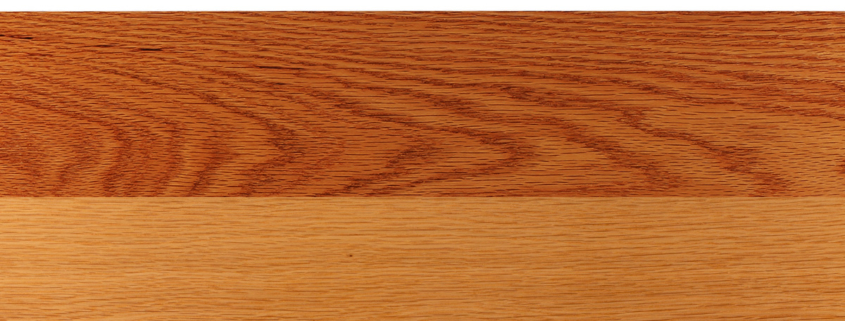Are Red Oak and White Oak Flooring the Same? Hear from the Experts!
There are a lot of hardwood flooring options out there, but certain species beat the rest when it comes to wood flooring applications.
White oak and red oak floors have been the standard for quite a while, but even though they both have oak in the name, they aren’t identical twins. There are some key differences, and if you’re considering red oak flooring or white oak flooring, those differences are important to know before you buy.
Color Differences
One of the main things people notice about unfinished (or naturally stained) red oak and white oak is the color difference. Let’s take a look.
Red Oak Flooring
Red oak has a warm, red to pinkish-brown hue, especially in its heartwood, with a more pronounced grain pattern (including color variations) when compared to white oak. That said, since red oak is more porous, it easily accepts a wide variety of stain colors, meaning that it’s easy to achieve whatever tint and tone you want. (We’ll talk a little more about the benefits of this later on.)

White Oak Flooring

White oak hardwood floors have a lighter color with creamy or light brown undertones. This type of hardwood flooring also accepts stain well, but its tighter grain pattern means the result will have a more uniform appearance.
See the Coloring Difference For Yourself
To get a look at both types of wood, follow along with Steve Stack and Ben Baird as they talk over solid hardwood flooring options. In this quick video, they’ll explain each species of wood, both of which are shown with a natural finish.
Durability
When it comes to the oak family, these two species are a great option for hardwood flooring – they’re more resilient to wear and tear than many other species… not to mention that they look great, too!
Red Oak Flooring
Red oak wood sits at 1290 on the Janka hardness scale, which means it’s relatively durable compared to other wood species, such as walnut and cherry. While it can still take on dents like most other species, red oak is (and has been) one of the most popular hardwood flooring options.
White Oak Flooring
The Janka hardness rating for white oak wood is 1360, which puts it at the higher end of the durability spectrum. This makes it one of the most popular choices for high traffic areas, but that popularity comes with a higher price tag. (We’ll talk about that later on, too.)
Long story short, both red and white oak are great options for any area throughout the home. They stand up to mopping, vacuuming and high traffic.
Water Resistance
By nature, nothing made of wood is impervious to water. The tightness of the grain is one of the largest factors in boosting (or decreasing) water resistance.
Red Oak Flooring
Since the grain lines in red oak flooring are more porous, it can be susceptible to water damage. However, it can still make for a beautiful flooring opting in areas with low to moderate moisture exposure.
White Oak Flooring
White oak’s tighter wood grain means it’s one of the more resistant hardwoods when it comes to water damage – making it a popular choice among homeowners.

If your flooring (regardless of the type of oak or any other species) becomes damaged due to water, refinishing might be possible if the damage isn’t too severe.
Cupping or warping can sometimes be addressed by sanding and refinishing, while more significant water damage can warrant patching/replacing damaged boards. It’s extremely important to address water issues as soon as possible to prevent the need for complete replacement.
Red Oak Flooring vs White Oak Flooring Prices
There’s no doubt about it; red oak flooring is more cost-effective than white oak flooring. White oak trees tend to grow a little more slowly than red oak, which can mean a higher cost per square foot. Add to that the popularity of the white oak species over the course of the past decade (the law of supply and demand), and it’s no wonder that the price points differ.
But, the good news is that red oak can mimic white oak as long as you know what you’re doing! Both can utilize the same types of sawing techniques (ex. quarter sawn flooring), making it tough to tell the difference when certain stains are used.
Medium to dark stains are trending significantly, and both options make the differences between red and white oak nearly impossible to perceive.
In the end, opting for red oak flooring over white oak flooring can almost cut your cost in half!
Explore More Hardwood Flooring Options
Now you know the difference between red oak and white oak flooring – but those aren’t your only options when it comes to high-quality hardwood flooring. From quarter sawn white oak to hard maple and Brazilian cherry, find what you need by visiting us online. Or, if you’re looking for more interior design ideas, download our catalog. We’re ready and waiting to deliver the best hardwood products directly to your home!




